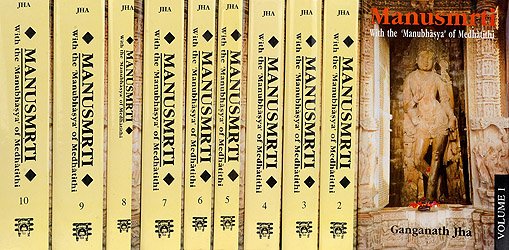Manusmriti with the Commentary of Medhatithi
by Ganganatha Jha | 1920 | 1,381,940 words | ISBN-10: 8120811550 | ISBN-13: 9788120811553
This is the English translation of the Manusmriti, which is a collection of Sanskrit verses dealing with ‘Dharma’, a collective name for human purpose, their duties and the law. Various topics will be dealt with, but this volume of the series includes 12 discourses (adhyaya). The commentary on this text by Medhatithi elaborately explains various t...
Verse 8.257
Sanskrit text, Unicode transliteration and English translation by Ganganath Jha:
यथोक्तेन नयन्तस्ते पूयन्ते सत्यसाक्षिणः ।
विपरीतं नयन्तस्तु दाप्याः स्युर्द्विशतं दमम् ॥ २५७ ॥yathoktena nayantaste pūyante satyasākṣiṇaḥ |
viparītaṃ nayantastu dāpyāḥ syurdviśataṃ damam || 257 ||If they decide in the right manner, they, being truthful witnesses, become purified; but if they decide contrariwise, they should be made to pay a fine of two hundred.—(257)
Medhātithi’s commentary (manubhāṣya):
If, on reference to other proofs and to other more reliable witnesses, it is found that the witnesses have not deposed truthfully, each of them shall he fined two hundred; because each of them is a ‘witness’ and that penalty has been prescribed for the ‘witness’; and all the witnesses do not depose collectively.
‘Truthful witnesses’;—i.e., witnesses who lay a great stress upon veracity.
‘Become purified,’;—i.e., do not incur the guilt of telling a lie.
‘In the right manner’;—i.e., in accordance with facts. This phrase cannot be taken as referring to anything that has been said (which is what the term ‘ukta’ actually denotes); all that is meant is that what they declare is corroborated by other proofs. Or, it may mean ‘in accordance with what has been declared in the scriptures,’ in the way of truthfulness. It has been declared in the scriptures that ‘one shall speak the truth’; hence the phrase ‘yathoktena’ means in a truthful manner.—(257)
Explanatory notes by Ganganath Jha
This verse is quoted in Mitākṣarā (2.153), as laying down the penalty for witnesses lying in connection with boundaries;—in Vivādaratnākara (p. 211), which explains ‘Satyasākṣinaḥ’ as ‘those persons who depose truthfully to the boundary,’—and ‘dviśatam’ as ‘two hundred paṇas’;—in Vyavahāramayūkha (p. 97);—in Vivādacintāmaṇi (p. 95);—in Kṛtyakalpataru (112a);—and in Vīramitrodaya (Vyavahāra, 141a).
Comparative notes by various authors
(verses 8.253-264)
See Comparative notes for Verse 8.253.
